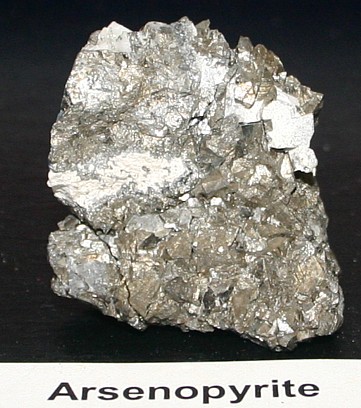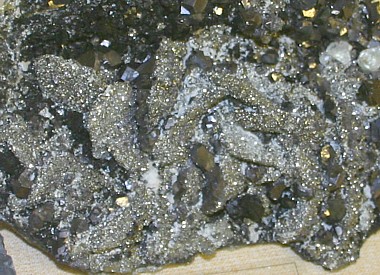|
.Arsenopyrite Mineral Facts:
Chemical Formula: FeAsS
- 46% Arsenic by weight
Colors:
Silver to steel gray in color. Streak
is black.
Hardness:
5.5 to 6
Density: 6
to 6.2
The density
is high because of the large silver content.
Cleavage:
No cleavage
but the mineral is brittle and its fracture uneven.
Crystallography: Orthorhombic
Usually in tabular diamond shaped crystals, formed by a short prism
terminated by low brachydomes.
Twinned at times, giving stellate
groups.
Luster:.
Metallic luster.
Optics:
(Refractive Index): Opaque
|
 |
|
Composition,
Structure and Associated Minerals:
Arsenopyrite, or mispickel, is the most important ore of arsenic. It
is found in crystals and in compact and granular masses. It is a
silver-white metallic mineral resembling very closely cobaltite in its
general appearance.
In many specimens the iron is replaced in part by cobalt, nickel or
manganese. Sometimes the cobalt is present in such large quantity that the
mineral is smelted as an ore of this metal. Arsenopyrite is the
most common mineral containing arsenic. Found in veins in crystalline rocks,
associated with ores of tin, silver, lead and with various
sulfides
, including
pyrite,
chalcopyrite,
sphalerite,
galena,
etc. Sometimes it is auriferous and serves as a
gold
ore.
Identification and Diagnostics
Recognized usually by its
silver-white color, its crystals and a test for arsenic. The mineral yields
sparks when struck with steel and emits an arsenic smell.
It dissolves in nitric acid with the
separation of sulfur.
Arsenopyrite is distinguished from
the cobalt sulfides and arsenides by the absence of large amounts of cobalt.
Fusible at 2 to a magnetic
globule. B. B. on charcoal gives a volatile coating of arsenious oxide and a
characteristic garlic odor. In 0. T. gives odor of sulfur dioxide and a
volatile ring of arsenious oxide. In C. T. gives arsenic mirror. It is a
good conductor of electricity.
Occurrence,
Localities and Origins:
Occurrence. Arsenopyrite crystals
are often found disseminated through crystalline rocks, and often embedded
in the gangue minerals of veins. Like pyrite and marcasite they frequently
fill
vein fissures. Its associates are silver, tin and lead ores,
chalcopyrite, pyrite and sphalerite. The mineral is abundant at
Freiberg, in Saxony, at Tunaberg, in Sweden, and at Inquisivi Mt., Sorato,
in Bolivia; with tin ores in Cornwall, England; New South Wales and Deloro,
Canada, where it is mined as a gold ore. It also occurs in fine crystals at Franconia in
New
Hampshire, at
Blue Hill in Maine, at Chatham in Connecticut, and at St. Francois,
Beauce Co., Quebec. Massive arsenopyrite is found near Keeseville Essex Co.,
near Edenville, Orange Co., and near Carniel, Putnam Co., N. Y., and at
Rewald, Floyd Co.., Va. In most cases it is apparently a result of
pneumatolysis.
Arsenopyrite was formerly the
source of nearly all the arsenic of commerce. The mineral is concentrated by
mechanical methods, and the concentrates are heated in retorts.
When the mineral contains
a reasonable amount of
cobalt or of gold these metals are extracted. The metal
arsenic has very little use in the arts, though its compounds find
many
applications as insecticides, medicines,
pigments, in tanning,
etc.
Return to the
Mineral Collectors Information Page |

Arsenopyrite, small crystals |
|


